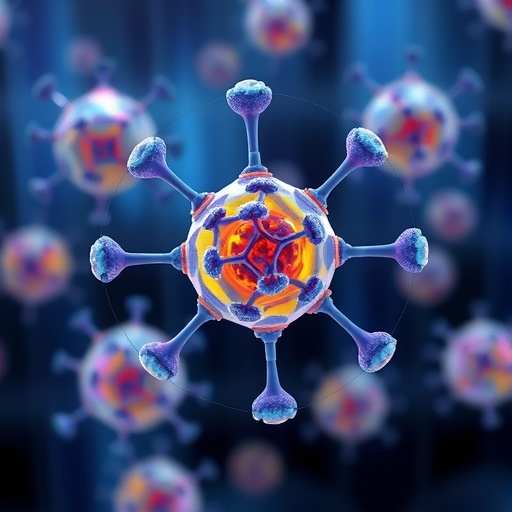The landscape of cancer treatment is undergoing a transformative evolution, driven by the cutting-edge integration of nanotechnology and immunotherapy. A recent comprehensive review published in Nature Reviews Clinical Oncology by Linderman, DeRidder, Sanjurjo, and colleagues explores the burgeoning potential of tumour-responsive nanomaterials to amplify the precision and potency of immunotherapies. Unlike traditional systemic administration, which often suffers from debilitating on-target off-tumour toxicities and limited efficacy due to the immunosuppressive nature of the tumour microenvironment (TME), these smart nanomaterials offer a paradigm shift towards safer, more effective cancer management.
At the core of this innovation is the ability of engineered nanomaterials to respond dynamically to unique hallmarks of the TME. Tumours create a markedly distinct microenvironment characterized by aberrant pH levels, elevated reductive potential, increased reactive oxygen species (ROS), hypoxic conditions, specific enzymatic profiles, and high concentrations of adenosine triphosphate (ATP). These biochemical and biophysical anomalies provide a rich toolkit for designing nanocarriers that selectively release therapeutic payloads where they are needed most, sparing healthy tissues from collateral damage.
One of the most promising applications involves immune checkpoint inhibitors, molecules that unleash the body’s own T cells to attack cancer cells but are often hindered by systemic toxicity and poor tumour penetration when administered conventionally. Nanoparticles that sense acidic pH or enzymatic markers within the tumour can ensure that checkpoint blockade reagents are only activated or released in situ, dramatically reducing off-target side effects and enhancing local immune activation. This spatial precision not only improves patient safety but also maximizes antitumour efficacy.
.adsslot_L4iDtewJvW{ width:728px !important; height:90px !important; }
@media (max-width:1199px) { .adsslot_L4iDtewJvW{ width:468px !important; height:60px !important; } }
@media (max-width:767px) { .adsslot_L4iDtewJvW{ width:320px !important; height:50px !important; } }
ADVERTISEMENT
Beyond checkpoint inhibitors, cytokines—which serve as vital signaling proteins regulating immune responses—have historically been limited by systemic toxicities and rapid degradation. Tumour-responsive nanomaterials present a powerful solution by protecting cytokines as they circulate and releasing them precisely within the TME where their immunostimulatory properties are most impactful. This targeted approach encourages anti-tumour immune activity while mitigating the severe side effects that have hampered cytokine therapies.
Further advancing the frontier, nanotechnology is enabling the delivery of mRNAs and vaccines tailored to initiate robust immune responses specifically against tumour-associated antigens. The harsh extracellular conditions of the TME that typically degrade these fragile molecules can be circumvented through protective nanocarrier design, which responds to oxidative stress or hypoxia to trigger release. These systems invigorate dendritic cells and prime cytotoxic T lymphocytes in a highly localized fashion, driving a potent and sustained antitumour response.
Intriguingly, the potential application of nanoparticle-based delivery extends to even more complex therapeutics such as chimeric antigen receptor (CAR) constructs. While CAR-T cell therapy has revolutionized treatment for some hematologic malignancies, its extension to solid tumours remains challenging. Tumour-responsive nanomaterials could conceivably ferry CAR-encoding mRNAs or other components directly to resident immune cells within the TME, sidestepping the need for ex vivo cell manipulation and expanding the reach of cellular therapies.
An additional layer of sophistication arises from nanomaterials engineered to modify the extracellular matrix (ECM) and induce immunogenic cell death. The dense, fibrotic ECM characteristic of many tumours acts as both a physical and biochemical barrier to immune infiltration. Nanoparticles responsive to specific enzymatic milieus can release ECM-modulating agents, loosening the tumour stroma and facilitating immune cell penetration. Likewise, triggering immunogenic cell death through oxidative or reductive stimuli enhances antigen presentation, further stimulating adaptive immune responses.
Underpinning the success of these engineered nanocarriers are the intricacies of their stimuli-responsive mechanisms. pH-sensitive linkers, redox-responsive bonds, enzyme-cleavable motifs, and oxygen-sensitive drug release systems exemplify the molecular ingenuity harnessed to achieve exquisite spatiotemporal control. The heterogeneity and dynamism of the TME demand such multi-modal responsiveness, ensuring that nanomaterials adapt and function optimally within complex biological contexts.
Preclinical models have demonstrated compelling outcomes with these approaches, featuring improved tumour regression and survival benefits in animal studies. Encouragingly, several formulations have transitioned into clinical trials, highlighting the translational momentum of tumour-responsive nanotherapy platforms. These early human studies focus on safety, biodistribution, and preliminary efficacy, setting the stage for next-generation immunotherapies that may revolutionize patient care paradigms.
Nevertheless, despite these advances, significant hurdles remain along the path to clinical integration. The scalability of nanomaterial production, reproducibility across batches, comprehensive toxicity profiling, and regulatory approval processes pose formidable challenges. The intricate interplay of nanocarrier properties with patient-specific tumour biology also necessitates personalized approaches and sophisticated biomarker strategies to optimize treatment selection.
Looking toward the future, the convergence of materials science, immunology, and oncology promises to refine tumour-responsive nanomaterials into highly tailored, multifunctional platforms. Integration with real-time imaging and diagnostic tools could enable feedback-controlled delivery systems, ushering in an era of precision immunotherapy with adaptive dosing and dynamic response to tumour evolution.
Moreover, the expanding understanding of TME biology—including spatial and temporal heterogeneities—will inform the rational design of next-generation nanomedicines. Cutting-edge single-cell and spatial transcriptomics, combined with machine learning algorithms, may identify novel stimuli and highly specific molecular triggers to enhance targeting fidelity further.
Ultimately, these innovative nanomaterial-based immunotherapies hold the transformative potential to overcome the classic barriers limiting traditional systemic treatments. By harnessing the unique properties of tumour microenvironments and coupling them with responsive delivery mechanisms, these platforms promise to tilt the balance in favor of durable antitumour immunity, reduced systemic toxicities, and improved clinical outcomes for cancer patients worldwide.
In conclusion, the journey from bench to bedside for tumour-responsive nanomaterials is well underway, driven by compelling preclinical evidence and emerging clinical validation. The integration of smart nanotechnology with immunotherapy offers a beacon of hope in the challenging fight against cancer, aspiring to deliver treatments with unmatched precision and efficacy. Continued interdisciplinary collaboration, innovative engineering, and rigorous translational efforts will be crucial to realizing the full potential of these revolutionary approaches that may redefine cancer care in the near future.
Subject of Research: Targeted delivery of immunotherapies using tumour-responsive nanomaterials to overcome the limitations of conventional systemic cancer treatments and the immunosuppressive tumour microenvironment.
Article Title: Enhancing immunotherapy with tumour-responsive nanomaterials.
Article References:
Linderman, S.W., DeRidder, L., Sanjurjo, L. et al. Enhancing immunotherapy with tumour-responsive nanomaterials.
Nat Rev Clin Oncol 22, 262–282 (2025). https://doi.org/10.1038/s41571-025-01000-6
Image Credits: AI Generated
Tags: biocompatible nanocarrierscancer treatment innovationsimmune checkpoint inhibitorsimmunotherapy enhancementnanotechnology in oncologypersonalized cancer therapiesprecision medicine in oncologyreducing systemic toxicity in cancer therapytargeted drug delivery systemstherapeutic payload release mechanismstumor microenvironment dynamicstumor-responsive nanomaterials





